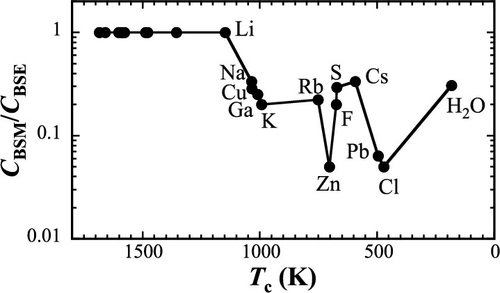当前位置:
X-MOL 学术
›
ACS Earth Space Chem.
›
论文详情
Our official English website, www.x-mol.net, welcomes your
feedback! (Note: you will need to create a separate account there.)
H2O and Other Volatiles in the Moon, 50 Years and on
ACS Earth and Space Chemistry ( IF 2.9 ) Pub Date : 2020-07-28 , DOI: 10.1021/acsearthspacechem.9b00305 Youxue Zhang 1
ACS Earth and Space Chemistry ( IF 2.9 ) Pub Date : 2020-07-28 , DOI: 10.1021/acsearthspacechem.9b00305 Youxue Zhang 1
Affiliation

|
In the 50 years since the first lunar sample return, the investigation of H2O in the Moon has experienced several stages of developments and paradigms. In the early years since Apollo sample return, only bulk soil and bulk rock samples were analyzed for H2O as well as other volatiles. From 1970 to 2007, it was thought that the Moon is essentially devoid of innate H2O, containing probably less than 1 ppb. New technologies gradually enabled the measurements of H2O in lunar glass beads, soil glass, minerals such as apatite and anorthite, and olivine-hosted melt inclusions. The advancements in measurement techniques led to improved data and new insights. Starting from 2008, significant H2O in deep-sourced lunar rocks has been reported, resulting in a paradigm shift from a bone-dry Moon to a fairly wet Moon, although there is still debate about whether the bulk silicate Moon contains ∼100 ppm of H2O (similar to that in the Earth’s MORB mantle) or only a few ppm H2O. The advances on our knowledge of H2O in the Moon is accompanied by increased understanding of other volatiles in the Moon. Gradually, the degrees of depletion of various volatiles in the Moon relative to the Earth were inferred. Using assessed data from available lunar samples, mostly the melt inclusions, and also bulk rock analyses, it is found that the inferred degrees of depletion for volatile elements in the Moon relative to the Earth do not vary much and are independent of the condensation temperature. It is proposed that an early veneer delivered the volatiles to both the Earth and the Moon, but the Moon received proportionally less of the early veneer planetesimals. In addition to H2O in the interior of the Moon, significant surface H2O in the form of ice in lunar polar regions and structural OH in agglutinate glass in lunar regolith originating from solar wind implantation has also been gradually quantified.
中文翻译:

50年及以后的H 2 O和月球中的其他挥发物
自第一次登月样品返回以来的50年中,对月球中H 2 O的研究经历了发展和范式的几个阶段。自阿波罗样本返回以来的最初几年,仅分析了散装土壤和散装岩石样品中的H 2 O以及其他挥发物。从1970年到2007年,人们认为月球基本上不含先天H 2 O,其含量可能低于1 ppb。新技术逐渐实现了对月球玻璃珠,土壤玻璃,磷灰石和钙长石等矿物以及橄榄石中熔体包裹体中H 2 O的测量。测量技术的进步带来了改进的数据和新见解。从2008年开始,H 2据报道,在深层月球岩石中存在O,导致从干燥的月球转变为相当潮湿的月球的模式转变,尽管仍存在关于硅酸盐大块月球是否含有约100 ppm H 2 O的争论(类似于在地球的地幔MORB),或只有几个ppm ^ h 2 O.我们h的知识进步2月亮中的O伴随着对月亮中其他挥发物的更多了解。逐渐推断出月球中各种挥发物相对于地球的消耗程度。使用来自可用月球样品的评估数据(主要是熔体夹杂物,以及块岩分析),发现推断的月球中挥发性元素相对于地球的耗竭程度变化不大,并且与凝结温度无关。有人提出,早期的单板将挥发物传递到地球和月球上,但月亮按比例减少了早期单板的小行星。除月球内部的H 2 O外,重要的表面H 2还已逐渐量化了月球两极区域中冰的形式的O和太阳风植入引起的月结石中凝结玻璃中结构OH的含量。
更新日期:2020-09-18
中文翻译:

50年及以后的H 2 O和月球中的其他挥发物
自第一次登月样品返回以来的50年中,对月球中H 2 O的研究经历了发展和范式的几个阶段。自阿波罗样本返回以来的最初几年,仅分析了散装土壤和散装岩石样品中的H 2 O以及其他挥发物。从1970年到2007年,人们认为月球基本上不含先天H 2 O,其含量可能低于1 ppb。新技术逐渐实现了对月球玻璃珠,土壤玻璃,磷灰石和钙长石等矿物以及橄榄石中熔体包裹体中H 2 O的测量。测量技术的进步带来了改进的数据和新见解。从2008年开始,H 2据报道,在深层月球岩石中存在O,导致从干燥的月球转变为相当潮湿的月球的模式转变,尽管仍存在关于硅酸盐大块月球是否含有约100 ppm H 2 O的争论(类似于在地球的地幔MORB),或只有几个ppm ^ h 2 O.我们h的知识进步2月亮中的O伴随着对月亮中其他挥发物的更多了解。逐渐推断出月球中各种挥发物相对于地球的消耗程度。使用来自可用月球样品的评估数据(主要是熔体夹杂物,以及块岩分析),发现推断的月球中挥发性元素相对于地球的耗竭程度变化不大,并且与凝结温度无关。有人提出,早期的单板将挥发物传递到地球和月球上,但月亮按比例减少了早期单板的小行星。除月球内部的H 2 O外,重要的表面H 2还已逐渐量化了月球两极区域中冰的形式的O和太阳风植入引起的月结石中凝结玻璃中结构OH的含量。











































 京公网安备 11010802027423号
京公网安备 11010802027423号